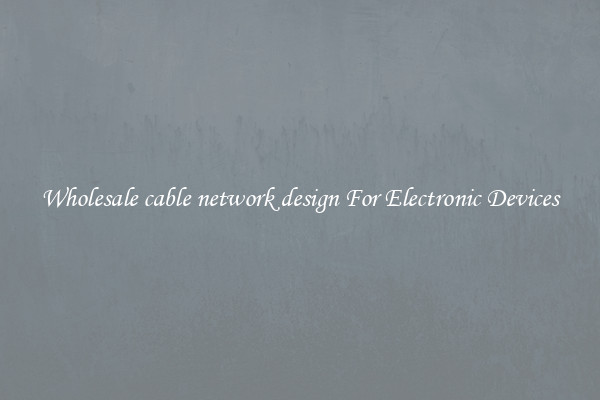Wholesale cable network design For Electronic Devices
Wholesale cable network design for electronic devices is a crucial aspect of creating efficient and reliable connectivity solutions. In today's technologically advanced world, where electronic devices are an integral part of our lives, it is essential to have a well-designed cable network to support seamless communication and data transfer.

One of the primary considerations for wholesale cable network design is the type of electronic devices that will be connected. Different devices have varying connectivity requirements, such as speed, bandwidth, and data transfer capacity. For instance, a network that supports high-definition video streaming on smart TVs will require cables with higher bandwidth and capacity, while a network for office computers may not have such demanding requirements.
Many wholesale cable network designs use fiber optic cables due to their high performance and reliability. Fiber optic cables can transmit data at much higher speeds and over longer distances compared to traditional copper cables. This is especially beneficial for large-scale networks that need to support multiple devices and relay data across vast areas. Fiber optics also have the advantage of being immune to electromagnetic interference, ensuring stable and consistent connectivity.
Another crucial consideration for wholesale cable network design is scalability. As electronic devices continue to evolve and become more advanced, the network should be able to accommodate future technology upgrades and expansions. Designing a network with scalability in mind ensures that it can easily adapt to changing requirements without significant disruptions or costly infrastructure upgrades.
In addition to scalability, network security is an essential aspect of wholesale cable network design. With the increasing threat of cyberattacks and data breaches, it is crucial to implement robust security measures to protect sensitive information transmitted through the network. This includes implementing encryption protocols, firewalls, and other security measures to mitigate potential risks.
Furthermore, the physical infrastructure of the cable network should be considered during the design process. Proper cable management, including routing and organizing cables, ensures easy installation, maintenance, and troubleshooting. Cable management also helps minimize signal degradation and interference, resulting in better overall network performance.
In conclusion, wholesale cable network design for electronic devices is a critical component of creating efficient and reliable connectivity solutions. Factors such as device requirements, scalability, security, and cable management must be carefully considered during the design process. By focusing on these aspects, businesses can ensure a robust and future-proof network infrastructure that supports the seamless communication and data transfer essential for electronic devices in today's digital world.

View details

View details

View details

View details








